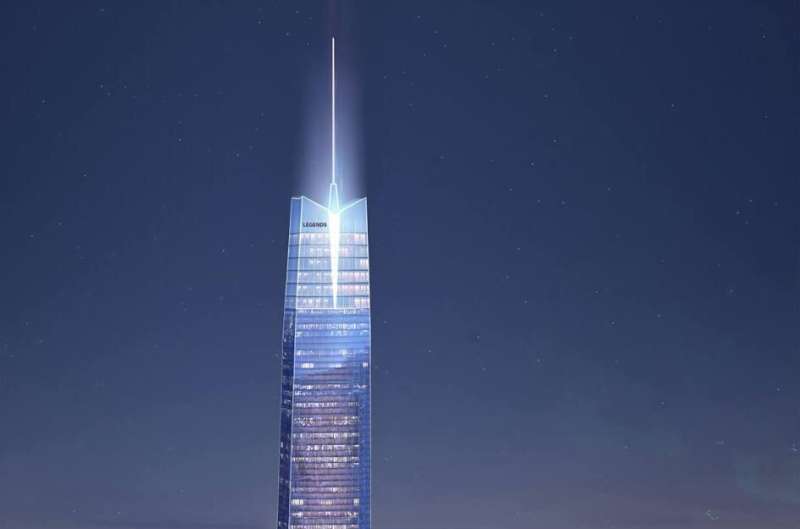
A 1,907-foot tall building could soon be erected as the tallest skyscraper in the United States. Can you guess where it may be built?
New York City or Chicago would probably be on the list. Perhaps San Francisco or Boston. Maybe even Miami.
How about Oklahoma City?
Last week, developers behind the luxury Boardwalk at Bricktown development being built in the city announced plans to increase the height of the project's "supertall tower" from 1,750 feet to 1,907 feet. That would make it the tallest structure in the country and the sixth-tallest in the world.
Oklahoma City isn't exactly known for its impressive skyline. The tallest building currently in the city is the Devon Energy Center, standing at 844 feet. The next tallest after that is BancFirst Tower at 500 feet. Oklahoma City has two buildings at or above 500 feet, New York City has more than 300.
Oklahoma is also one of several states located in the middle of Tornado Alley, an area in the United States known to be more susceptible to tornadoes. Other states in the alley include Texas, Kansas, Nebraska, South Dakota, Indiana, Missouri, Iowa and Ohio. Oklahoma had 74 tornadoes alone last year, according to the National Weather Service.
Jerome F. Hajjar, Northeastern professor civil and environmental engineering, says projects like these not only highlight the work of developers but also the broader region and the future of the area. And paramount is building with sustainability and safety in mind, he says.
"Signature structures like these say a lot about the region," he says. "They say a lot about the potential for the future. I've been working to help shift the profession so that sustainability and resilience are our premier design objectives. I think any building, especially a signature one like this, should think about these things."
One World Trade Center in New York City currently holds the title for the tallest building in the country, coming in at 1,776 feet. Worldwide, it's the seventh-tallest.
The Oklahoma City high-rise, officially named the Legends Tower, is just one component of a larger 5 million-square-foot development—standing in front of the high-rise structure will be three smaller 345-foot buildings.
Once completed, the $736 million development will be home to two Hyatt hotels, 1,776 residential units, and more than 110,000 square feet of commercial space.
Matteson Capital, the real estate development company behind the project, says it will request a variance from the city to approve the increased height of the building. However, city officials have said the change will actually require for the property to be rezoned.
Northeastern Global News caught up with Hajjar to get his thoughts on the development and the importance of sustainable development.
These responses have been edited for clarity and brevity:
Oklahoma is in the middle of Tornado Alley. What could be done from an engineering standpoint to make sure this building is protected from tornados?
Tornadoes are a significant hazard in that region and this structure would need to be designed for it, not only for the integrity of the structure as a whole, but also for the integrity of the cladding.
Note: Cladding, which serves as the building's "skin," envelopes a building's exterior with protective and decorative materials. The construction technique shields a building from external elements like weather, UV rays and temperature fluctuations.
Can you speak about structural engineering advancements in the past several decades that have enabled developers to build these high-rise buildings?
There have certainly been major developments and approaches that we're able to use to predict the behavior of these structures, to design and ensure stability for extreme events. In this region, we've developed great capabilities to use wind tunnels to understand those wind loads better. We've enhanced the stability theories that we use to design so this allows us to bring in efficiencies in the materials so we can use less materials than we have some decades ago.
In order to design something like this, we're continually innovating with respect to structural configurations that are available to be able to resist extreme loads. Sometimes there can be innovations and new materials that can be used. All of this has helped to enable something like this.
This story is republished courtesy of Northeastern Global News news.northeastern.edu.
Citation: Q&A: Tallest building in US planned for the middle of Tornado Alley. Will it withstand the region's extreme weather? (2024, January 29) retrieved 29 January 2024 from https://techxplore.com/news/2024-01-qa-tallest-middle-tornado-alley.html
This document is subject to copyright. Apart from any fair dealing for the purpose of private study or research, no part may be reproduced without the written permission. The content is provided for information purposes only.
